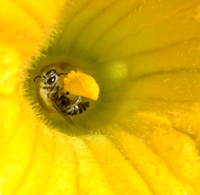 | Your squash needs bees' help
|
Give thanks for pollinators!As you're eating your squash this Thanksgiving, remember who made it possible: a bee! While you're at it, thank the bees for your cranberries, pumpkin pie, and the whipped cream on top (since alfalfa, eaten by cows, requires pollination). And though the honey you may use is produced by (non-native) honey bees, remember that our native bees are even better pollinators and extremely important for pollinating many foods!
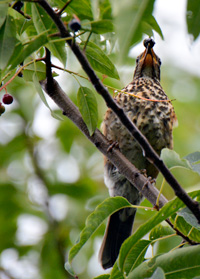 | |
Besides berries, this native cherry is a host plant for caterpillars - essential food for baby birds
|
Our Nov. 30 Program: Doug TallamyNo, not in person, but by way of the Wild Ones video. We saw one Doug Tallamy video last year, and it got rave reviews. This is a different video, so even if you saw last year's video, you'll find lots to learn in this one. And Doug Tallamy is always inspiring as well as educational.
When: Sunday, November 30 at 2 pm Where: Liverpool Public Library ( Directions) Free and open to the public, so bring a friend or two! Janet Allen, President, HGCNY
|
 |
 |
This winter wren proves it!
|
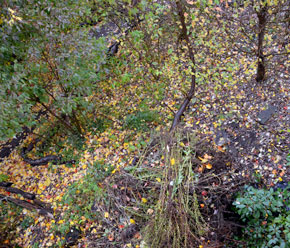 | |
Winter wren habitat (photo taken from above)
|
We talk all the time about providing habitat for birds, butterflies, bees, and other creatures, and native plants are a critical part of that habitat. But the overall structure of the places we provide is important as well. I found this out when I spotted a winter wren in my yard for the first time. The descriptions of its preferred habitat helped me identify it. As All About Birds says, it "(f)eeds methodically in low shrubs, on the ground, near the bases of trees, and around fallen dead wood." Precisely! The paths in this part of my yard are lined with dead wood, and I have lots of shrubs and trees in this area. I indeed saw this perky little bird working around the base of these pagoda dogwoods and exploring the dead wood logs, looking for insects. Another part of the description fits well, too. As the Stokes Field Guide to Birds says, it's "rather secretive." To say the least! Despite diligent efforts, including hanging out the second story window with my camera, hoping to catch it unawares, the bird maintained its secrecy, disappearing in the blink of an eye whenever it spotted me. But the picture of the habitat is telling. Although I would have liked a photo of the bird, to me this photo captures the essence of the bird in a different fashion. As far as I could tell, it didn't explore the rest of my habitat garden, preferring this combination of features present in a small part of my yard. Planning for a diversity of habitat areas in our landscapes provides for more types of birds and other creatures.
|
 |
Being in nature is good for people, esp. kids
|
 | | The timeless joy of playing in the mud |
Wildlife needs food, water, cover, and a place to raise young. So do people! We find the sources of these necessities in the natural world in various forms, but we can also find something else if we look for it. As Richard Louv says in The Nature Principle:
"Young, old, or in between, we can reap extraordinary benefits by connecting--or reconnecting--to nature. For the jaded and weary among us, the outdoor world can expand our senses and reignite a sense of awe and wonder not felt since we were children; it can support better health, enhanced creativity, new careers and business opportunities, and act as a bonding agent for families and communities. Nature can help us feel fully alive."More info on people in nature is at www.OurHabitatGarden.org/habitat/people.html. More info on children is at www.OurHabitatGarden.org/habitat/children.html and for schools at www.OurHabitatGarden.org/habitat/schools.html.
|
Arrival time: October 30 at 6:35 pm
|
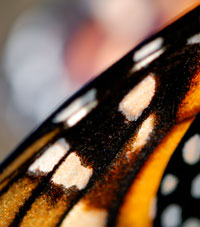 Right on schedule, monarch watchers in Mexico reported seeing three monarchs on Oct. 30 at 6:35 pm. The monarchs have traditionally arrived by Nov. 1, Mexico's Day of the Dead, and their arrival symbolizes their ancestors' souls arriving for their annual visit to earth. The Sierra Madres are a major monarch highway, and the winds give the monarchs a boost on the final leg of their journey. Here is Journey North's map showing the probable monarch migration pathway. The monarchs will continue arriving for the next 5-6 weeks. |
|
Project FeederWatch starts Sat. Nov. 9
|
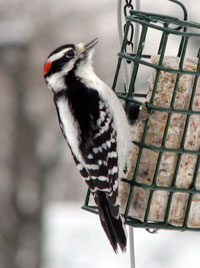 | | Downy woodpecker |
Although you can join in anytime, Project FeederWatch officially starts this Sat. Nov. 9. The project is almost entirely funded by the $18 participation fee ($15 for members). Here is all the information on how to participate, including an instructional video. To sign up to participate and to explore the treasure trove of information collected, go to Project FeederWatch at feederwatch.org.
|
|
|
Love your land?
Make a Plan!
|
Cornell Cooperative Extension of Onondaga County and Finger Lakes Land Trust will present a workshop for rural landowners and their families to help them plan for the future of their land.
WHEN: Nov. 14, 9:30 - 3:30 WHERE: First Presbyterian Church, 97 E. Genesee St., Skaneateles COST: $25/family Pre-register on the CCE Onondaga website For more info: Call Kristina Ferrare at 315.424.9485 ext. 231 or email kaf226@cornell.edu
|
Since HGCNY is a chapter of the national organization Wild Ones, when you become a member of Wild Ones, you're automatically a member of HGCNY, too. And since Wild Ones is an official not-for-profit, your membership is tax-deductible.
It's easy to become a member, receive the bimonthly Wild Ones Journal, and support our mission.
|
As more of us participate on our Facebook page at www.facebook.com/hgcny, this will become a useful resource for asking (and answering!) local HGCNYers' questions about habitat gardening.
|
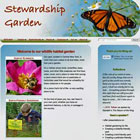 Visit Our Habitat Garden website for information on providing habitat, earth-friendly gardening practices, plants, and various creatures here in Central New York. |
Visit Our Edible Garden website to see an example of a local vegetable and fruit garden. An edible garden is a perfect complement to your habitat garden.
|
|
 |
|